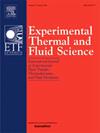Improvement of a wire-mesh sensor based on the bubble-wire collision kinematics
IF 2.8
2区 工程技术
Q2 ENGINEERING, MECHANICAL
Experimental Thermal and Fluid Science
Pub Date : 2024-11-21
DOI:10.1016/j.expthermflusci.2024.111363
引用次数: 0
Abstract
While the wire-mesh sensor (WMS) has been widely used to measure the gas-phase distribution in gas–liquid two-phase flows with visually inaccessible conditions, there are still some issues to be improved such as the dependency on the bubble size and bubble-wire interaction pattern. In our previous work [Lee et al., Int. J. Multiphas. Flow, 139, 103,620 (2021)], we reported the development and validation of a set of two-layer WMS, which can simultaneously measure the velocity and size of O(10−2–100) mm bubbles. In this study, considering the above-mentioned issues, we improve the measurement accuracy of the WMS, in particular, for relatively small (less than 2 mm) bubbles that tend to have asymmetric interactions with wires. To achieve this, we devised a new parameter to address the effect of non-uniform distance (proximity) to the nodes that are affected by the bubbles to be measured. Depending on the bubble-wire interaction (i.e., bubble size), we found that the characteristic time and length scales of the bubble vary, which are correlated with the proximity of bubbles to nodes with high electrical sensitivity. By implementing this into the algorithm, compared to the previous setup, the accuracy of measuring the averaged void fraction and velocity of bubbles increased by approximately 10 % and 20 %, respectively. We believe that the present approach will be quite useful in enhancing the measurement accuracy of other types (dual-set, for example) of wire-mesh sensors.
基于气泡线碰撞运动学改进线网传感器
虽然金属丝网传感器(WMS)已被广泛用于测量气液两相流中的气相分布,但仍有一些问题需要改进,如对气泡大小和气泡与金属丝网相互作用模式的依赖性。在我们之前的工作[Lee 等,Int. J. Multiphas. Flow,139,103,620 (2021)]中,我们报告了一套双层 WMS 的开发和验证,它可以同时测量 O(10-2-100) mm 气泡的速度和大小。在本研究中,考虑到上述问题,我们提高了 WMS 的测量精度,尤其是对相对较小(小于 2 毫米)的气泡的测量精度,因为这些气泡往往会与导线产生不对称的相互作用。为此,我们设计了一个新参数,以解决与待测气泡影响的节点的不均匀距离(接近度)的影响。根据气泡与导线的相互作用(即气泡大小),我们发现气泡的特征时间尺度和长度尺度各不相同,这与气泡是否靠近具有高电学灵敏度的节点相关。通过在算法中加入这一点,与之前的设置相比,测量气泡平均空隙率和速度的精度分别提高了约 10% 和 20%。我们相信,本方法对于提高其他类型(例如双组)金属丝网传感器的测量精度非常有用。
本文章由计算机程序翻译,如有差异,请以英文原文为准。
求助全文
约1分钟内获得全文
求助全文
来源期刊

Experimental Thermal and Fluid Science
工程技术-工程:机械
CiteScore
6.70
自引率
3.10%
发文量
159
审稿时长
34 days
期刊介绍:
Experimental Thermal and Fluid Science provides a forum for research emphasizing experimental work that enhances fundamental understanding of heat transfer, thermodynamics, and fluid mechanics. In addition to the principal areas of research, the journal covers research results in related fields, including combined heat and mass transfer, flows with phase transition, micro- and nano-scale systems, multiphase flow, combustion, radiative transfer, porous media, cryogenics, turbulence, and novel experimental techniques.
 求助内容:
求助内容: 应助结果提醒方式:
应助结果提醒方式:


